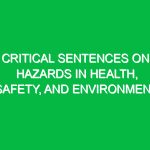Introduction
In the realm of construction and industrial activities, the phrase “scaffolds must be erected” resonates with significance, particularly within the Health, Safety, and Environment (HSE) domain. Scaffolding serves as a temporary structure that provides support for workers and materials during construction, maintenance, or repair tasks. Properly erected scaffolds are not merely about facilitating work; they are critical in ensuring a safe working environment, minimizing Hazards, and promoting environmental Sustainability. This article delves into the essential aspects surrounding the erection of scaffolds, exploring their relevance in the HSE context, the associated risks, regulatory compliance, and Best Practices.
Understanding Scaffolding in HSE Context
Scaffolding comprises various components like tubes, boards, and fittings that create a stable platform for workers. The phrase “scaffolds must be erected” emphasizes the necessity of constructing these structures according to rigorous Safety Standards and protocols to prevent accidents and ensure the well-being of workers.
The Importance of Scaffolds
Scaffolds are vital in various industries, including construction, maintenance, and even in the film industry for staging and lighting setups. They allow workers to access elevated areas safely, perform tasks efficiently, and transport materials with ease. However, the importance of erecting scaffolds goes beyond mere convenience; it is about safeguarding lives and protecting the environment.
Key Components of Scaffolding
Understanding the key components of scaffolding is essential for safe erection and usage. These include:
- Standards: Vertical posts that support the scaffolding structure.
- Ledgers: Horizontal bars that connect the standards and provide support for the platform.
- Braces: Diagonal components that stabilize the structure.
- Platforms: The surface on which workers stand.
- Guardrails: Safety features to prevent falls.
Every element must be meticulously designed and installed to ensure stability and Safety.
Risks and Hazards Associated with Improper Scaffolding
Despite the advantages of scaffolding, several risks can arise from improper erection and Maintenance. According to statistics from the Occupational Safety and Health Administration (OSHA), scaffold-related accidents account for a significant portion of construction injuries. Common hazards include:
- Falls: The leading cause of fatalities in the construction industry, often due to inadequate guardrails or unstable platforms.
- Structural Failure: Caused by overloading, improper assembly, or the use of defective materials.
- Electrocution: When scaffolds are erected too close to power lines, posing serious electrocution risks.
- Falling Objects: Tools or materials can fall from scaffolds, injuring workers below.
Mitigating these risks requires adherence to safety standards and comprehensive Training for all personnel involved in scaffold erection and use.
Best Practices for Erecting Scaffolds
To ensure that “scaffolds must be erected” not only as a formality but as a practice of utmost diligence, several Best Practices should be implemented:
1. Conduct a Risk Assessment
Before any scaffolding work begins, conduct a thorough risk assessment. Identify potential hazards, evaluate their impact, and develop strategies to mitigate them. This proactive approach not only protects workers but also enhances overall project efficiency.
2. Follow Manufacturer Guidelines
Always adhere to the manufacturer’s guidelines when erecting scaffolds. These instructions provide crucial information on load capacity, assembly Procedures, and maintenance requirements. Ignoring these guidelines can lead to catastrophic failures.
3. Ensure Proper Training
All personnel involved in scaffold erection should undergo rigorous training. This training should include safe assembly techniques, the importance of inspections, and emergency procedures. Regular refresher courses can further solidify this knowledge.
4. Regular Inspections
Scaffolds must be regularly inspected for structural integrity and safety compliance. Inspections should occur before use and at regular intervals during the project. Look for signs of wear, corrosion, or damage, and address any issues immediately.
5. Use Quality Materials
The quality of materials used in scaffolding is non-negotiable. Always choose high-grade steel or aluminum components that meet industry standards. Inferior materials can compromise the entire structure, leading to severe accidents.
6. Implement Fall Protection Systems
Installing guardrails and toe boards is essential to prevent falls. Additionally, consider using personal fall arrest systems (PFAS) for workers operating at heights. These measures significantly reduce the risk of fall-related injuries.
Regulatory Compliance in Scaffolding
Compliance with Regulations governing scaffolding is not just a legal obligation; it is a moral responsibility towards workers’ safety. Various regulatory bodies, like osha in the United States and the Health and Safety Executive (HSE) in the UK, provide guidelines outlining the standards for scaffold erection.
OSHA Standards
OSHA has established specific standards for scaffolding under 29 CFR 1926 Subpart L. These regulations cover aspects such as design, strength, load capacities, and Safe Usage practices. Employers must ensure that scaffolds are erected and disassembled in accordance with these standards to avoid penalties and, more importantly, to protect their workforce.
HSE Regulations
In the UK, the HSE stipulates that scaffolds must conform to the Work at Height Regulations 2005. This includes ensuring that all work at height is properly planned, supervised, and carried out by competent personnel. Regular inspections and maintenance are also mandated to ensure ongoing safety compliance.
Real-Life Examples and Case Studies
Real-life incidents illustrate the critical importance of proper scaffold erection. For instance, in 2016, a construction worker in New York fell from an improperly erected scaffold due to inadequate guardrails. The incident resulted in severe injuries and highlighted the need for stringent adherence to safety protocols.
Conversely, a notable success story comes from a large construction firm that implemented rigorous training and inspection protocols for their scaffolding operations. In just two years, they reduced their scaffold-related incidents by over 60%, showcasing that investment in safety pays off in both human and financial terms.
Conclusion
In conclusion, the phrase “scaffolds must be erected” embodies more than just a construction necessity; it represents a commitment to health, safety, and environmental stewardship. The erection of scaffolds is a critical component of ensuring safe working conditions, minimizing risks, and adhering to regulatory standards. By understanding the key elements, associated hazards, and best practices, stakeholders can create a safer environment for all involved in construction and maintenance activities.
As we move forward, it is imperative that industry professionals continue to prioritize scaffold safety, invest in training, and adhere to established regulations. Only through collective commitment and diligence can we ensure that scaffolding serves its purpose without compromising the health and safety of workers.


